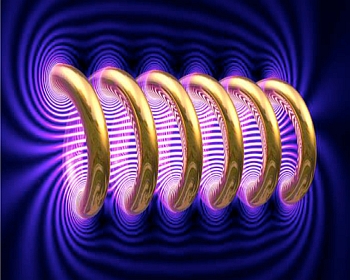ناقش قسم الفيزياء في كلية التربية للعلوم الصرفة (ابن الهيثم ) أطروحة الدكتوراه الموسومة (تحضير ودراسة بعض الخصائص الفيزيائية والتاثيرات الحياتية للمواد المغناطيسية النانوية وتطبيقاتها في إزالة المعادن الثقيلة من المحاليل المائية) للطالبة (حنان جميل مصطفى خضر) التي انجزتها باشراف التدريسية في القسم (أ.د. تغريد مسلم مريوش) و نوقشت من قبل أعضاء لجنة المناقشة المدرج أسمائهم فيما يأتي :
-
أ. د. صباح انور سلمان (رئيسا)
-
أ. د. وداد حمدي جاسم (عضوا)
-
أ. د. إنتصار عليوي لعيبي (عضوا)
-
أ. م. د. عبد الحميد رحيم مهدي (عضوا)
-
أ. م. د. ناهدة جمعة حميد (عضوا)
-
أ. د. تغريد مسلم مريوش (عضوا ومشرفا)
وتهدف هذه الدراسة إلى تحضير وتشخيص الجسيمات النانوية للمغنتيت في تركيبات مختلفة باستخدام طرق مختلفة للوصول إلى الجسيمات النانوية ذات الخصائص المثلى لإزالة أيونات الرصاص من المحاليل المائية ودراسة قدرتها على التثبيط ضد بعض أنواع البكتيريا الموجودة في الماء.
لقد أحدث التصنيع والأنشطة البشرية الأخرى العديد من المشاكل البيئية التي تؤثر في النهاية على صحة الكائنات الحية بشكل عام والبشر بشكل خاص. تعد المياه إحد اطوار البيئة المهمة التي تتلوث دائمًا نتيجة لهذه الأنشطة. لحل هذه المشكلة، تم تحضير جسيمات نانوية جديدة من المغنتيت (magnetite nanoparticles) وتغليفها بمواد عضوية مختلفة مثل حمض الفوماريك (fumaric acid, FA)، والصمغ العربيgum arabic, GA) )، وفورمات الصوديوم (sodium formate, SF) لامتزاز أيونات الرصاص من محاليل مائية مختلفة، والذي يعتبر كاحد المعادن المهددة للصحة. تم استخدام ثلاث طرق لتحضير المغنتيت ذو الجسيمات النانوية؛ الترسيب المشترك (co-precipitation)، الاحتراق التلقائي ل(السائل-الهلام) (sol-gel autocombustion)، والاحتراق التلقائي ل(السائل-الهلام) الأخضر(green sol-gel autocombustion) ، كما تم تحضير ثلاثة مركبات من الجسيمات النانوية للمغنتيت في هذا العمل وهي (4Fe3O)، و (Ni0.5Mg0.3Ag0.2Fe2O4)، و (Ni0.35-xMg0.15AgxFe2.5O4)، حيث (x) يمثل mol(0.1 ، 0.08 ، 0.06 ، 0.04 ، 0.02).
تم تشخيص الجسيمات النانوية للمغنتيت بواسطة جهاز حيود الأشعة السينية (x-ray diffractometer, XRD) ، ومجهر المسح الإلكتروني (scanning electron microscope, SEM) ، وجهاز حيود الأشعة السينية المشتت للطاقة (energy dispersive x-ray EDX) ، و مطياف (تحويلات فورير للاشعة تحت الحمراء (Fourier transform-infra red, FT-IR ) للتأكد من ترابط مواد التغليف بسطح الجسيمات النانوية.تم قياس الخصائص المغناطيسية باستخدام الجهاز (vibrating sample magnetometry, VSM). لقياس تراكيز أيونات الرصاص في المحاليل المائية ، تم استخدام مطياف الامتصاص الذري(atomic absorption spectrophotometer, AAS) .
أظهرت نتائج XRD أن الجسيمات النانوية للمغنتيت المحضر لها التركيب البلوري المكعبي المغزلي المعكوس(inverse spinel cubic) لأوكسيد الحديد (Fe3O4) بمتوسط حجم بلوري (average crystallite size, Dave) nm(49.170-11.993)، كثافة الأشعة السينية (x-ray density, ρ) (4.711-5.853) g/cm3، وثابت الشبيكة (lattice constant, a) Å(8.3) لاغلب العينات.
أثبتت صور SEM أن متوسط الحجم البلوري للجسيمات النانوية للمغنتيت المحضر (Dave) يكون ذو مدى نانويnm (22-44) وهي متجانسة، وموزعة بانتظام ، ولها أشكال تشبه الكرة. تم تأكيد وجود العناصر المكونة للمركبات المحضرة من خلال أطياف الطاقة التي تم تحليلها بواسطة مطياف EDX. فيما يتعلق بالسلوك المغناطيسي، أظهرت الجسيمات النانوية للمغنتيت المحضر مغناطيسية فائقة(superparamagnetism) في درجة حرارة الغرفة مع قيم واطئة لمغناطيسية التشبع (saturation magnetization, Ms) (0.30-50.28) emu/g ، التي تساعد في عملية استعادة الجسيمات النانوية للمغنتيت من المحاليل المائية.
أظهر تحليل أطياف FT-IR أن العينات المغلفة بـ (FA) أظهرت قمة مشتركة عند cm-1 (1600-1700) تعود الى الآصرة (C=O) الامتطاطية (stretch) التي تعزى الى حزم الطاقة المميزة لل (FA)؛ بينما أظهرت العينات المغلفة بـ (GA) قمة عريضة مشتركة عند cm-1(3400) تعود الى الآصرة (-OH) الموجودة في متعدد السكاريد (polysaccharide) في (GA). أخيرًا ، أظهرت العينة المغلفة بـ (SF) ثلاثة قمم والتي تعود للمجاميع الفعالة لل(SF)، والتي ظهرت عند ((1384 cm-1، و(1593 cm-1)، و(2843 cm-1) .
أظهرت العينة M6 افضل خصائص امتزاز عند زمن امتزاز (25) min ل GM6 و (10) min ل SM6، عند درجة حرارة (30 °C)، و (100 rpm)، و وزن المادة المازة .(0.1 g) معدلات الازالة لايونات الرصاص من محلول الاملاحPb(NO3)2) ) المحضر للعينات GM6 و SM6 كانت 95٪ و 93٪ على التوالي. بينما معدلات الازالة لايونات الرصاص من مياه الصرف المنقاة كانت )100٪( ل SM6 و)55٪) ل GM6.
لقد وجد أن ترتيب التراكيز المؤثرة للجسيمات النانوية للمغنتيت هو (0.5˃0.05 ˃0.01˃0.005)؛ بينما كان ترتيب البكتيريا المتاثرة هو (S. aureus)> (P. aeruginosa)> (E.Coli)> (K. pneumoniae). العديد من العوامل قد اثرت بشكل ايجابي على تثبيط الخلية البكتيرية وهي صغر حجم الجسيمات النانوية، والفعالية المضادة للبكتريا للعناصر المكونة للمركب، و الفرق في الشحنة بين المايكروب والجسيمات النانوية للمغنتيت.
وخلصت الطالبة الى التوصيات الاتية :
-
دراسة الفعالية المضادة للبكتيريا للعينات M10 ، M11 ، M15.
-
دراسة سعة الامتزاز للعينة M6 لقيم مختلفة لكل من التراكيز للجسيمات النانوية، ودرجة الحرارة، والاس الهيدروجيني، وتراكيز أيونات الرصاص.
-
دراسة الفعالية المضادة للبكتيريا للجسيمات النانوية للمغنتيت لأنواع أخرى من بكتيريا الماء.
-
دراسة قدرة الامتزاز للجسيمات النانوية للمغنتيت المحضرة لمعادن ثقيلة مختلفة مثل Cr و Cd و Hg.
-
استخدام الجسيمات النانوية للمغنتيت المحضرة في تقنية التناضح الأمامي المستخدمة لتنقية المياه.
-
تغليف الجسيمات النانوية للمغنتيت المحضرة بمادة مسحوق زهرة الكركديه ودراسة خصائصها الفيزيائية والامتزازية.
-
تغليف العينات M6 و M10 و M11 و M15 بفورمات الصوديوم (SF) وسترات ثلاثي الصوديوم (TSC) ومقارنة قدرتها على الامتزاز لمختلف المعادن الثقيلة.
-
تغليف الجسيمات النانوية للمغنتيت المحضرة بمادة مسحوق الأرز ودراسة خصائصها الفيزيائية والامتزازية.
-
تحضير الجسيمات النانوية للمغنتيت/فضة المشوبة بالمنغنيس ودراسة خصائصها المغناطيسية والفعالية المضادة للميكروبات.
– Preparation and Study of Some Physical Properties and Biological Effects of Nanomagnetic Materials and their Applications in the Removal of Heavy Metals from Aqueous Solutions
– Hanan Jamil Mustafa Khudur
– Prof. Dr. Tagreed Muslim Marush/ Department of Physics
– Aim of the Study: This study aims to prepare and characterize magnetite NPs in different compositions using different methods to reach the nanoparticles of the optimum properties for the removal of Pb ions from aqueous solutions and to study their inhibition capacity against some types of water-existed bacteria.
– Abstract: Industrialization and other human activities have introduced many environmental problems that eventually affect the health of living organisms in general and human beings in special. Water is one of the important environmental phases that always getting polluted as a consequence of these activities. To solve this problem a novel magnetite nanoparticles (NPs) have been prepared and coated with various organic substances as fumaric acid (FA), gum arabic (GA), and sodium formate (SF) to adsorb Pb ions from different aqueous solutions, which is considered as one of the most health-threaten metals. Three methods were used to prepare magnetite NPs; co-precipitation, sol-gel autocombustion, and green sol-gel autocombustion. Also, three compounds of magnetite NPs have been prepared in this work which are, (Fe3O4), (Ni0.5Mg0.3Ag0.2Fe2O4), and (Ni0.35-xMg0.15AgxFe2.5O4), where (x) equals to (0.1, 0.08, 0.06, 0.04, 0.02) mol.
Magnetite NPs were characterized by x-ray diffractometer (XRD), scanning electron microscope (SEM), energy dispersive x-ray diffractometer (EDX), and Fourier transform-infra red (FT-IR) spectrophotometer was used to make sure of attachment of coating materials to the nanoparticles surface. The magnetic properties was measured using vibrating sample magnetometry (VSM). For measuring Pb ions concentrations in the aqueous solutions, atomic absorption spectrophotometer (AAS) has been used.
XRD results showed that the prepared magnetite NPs have the crystal structure of inverse spinel cubic of the iron oxide (Fe3O4) with average crystallite size (Dave) (11.993-49.170) nm, x-ray density (ρ) (4.711-5.853) g/cm3, and lattice constant (a) 8.3Å for most of the samples.
SEM images proved that the average crystallite size (Dave) of the prepared magnetite NPs are in nano-range (22-44) nm and they are homogeneous, distributed regularly, and with sphere-like shapes. The existence of the prepared compounds constituent elements was confirmed by their energy spectra analyzed by EDX spectroscopy. Regarding the magnetic behavior, the prepared magnetite NPs have shown superparamagnetism at room temperature with low values of saturation magnetization (Ms) (0.30-50.28) emu/g, that assists the recovery process of the magnetic NPs from the aqueous solutions.
FT-IR spectra analysis appeared that the samples coated with FA showed a mutual medium peak at (1600-1700) cm-1 due to (C=O) stretch bond which attributed to the FA characteristic bands; while the samples coated with GA showed a mutual broad peak at (3400) cm-1 due to (-OH) bond, that exists in the polysaccharide of GA. Finally, the sample coated with SF has shown three peaks which return to the SF functional groups, which appeared at (1384 cm-1), (1593 cm-1), and (2843 cm-1).
The sample M6 showed the optimum adsorption properties at equilibrium time (25 min) for GM6 and (10 min) for SM6, at temperature (30 °C), (100 rpm), and adsorbent weight of (0.1 g). The removal rates for Pb ions from the prepared Pb(NO3)2 salts solution for the samples GM6 and SM6 were of 95% and 93%, respectively. While the removal rates of Pb ions from the purified wastewater were of (100%) for SM6, while for GM6 it was (55%).
It was found that the order of the effective concentrations of the magnetite NPs is 0.5>0.05>0.01>0.005; while the order affected bacteria was (S. aureus)> (P. aeruginosa)>(E.Coli)>( K. pneumoniae). Many factors were positively influenced on the inhibition of the bacterium cell which are the small size of the nanoparticles, the antibacterial activity of the constituent elements, and the difference in charge between the microbe and the magnetite NPs.
Future Work
-
Study the antibacterial activity for the samples M10, M11, M15.
-
Study the adsorption capacity for the sample M6 at different concentrations of NPs, temperature, pH, and different concentrations of Pb ions.
-
Study the prepared magnetite NPs antibacterial activity for other types of water bacteria.
-
Study the adsorption capacity for the prepared magnetite NPs for different heavy metals as Cr, Cd, and Hg.
-
Use the prepared magnetite NPs in the technique of forward osmosis for the application of water purification.
-
Coating the prepared magnetite NPs with hibiscus flower powder substance and study their physical and adsorption properties.
-
Coating the samples M6,M10, M11, M15 with sodium formate (SF) and trisodium citrate (TSC) and compare their adsorption capacity for different heavy metals.
-
Coating the prepared magnetite NPs with rice powder substance and study their physical and adsorption properties.
-
Prepare Mn doped Ag magnetite NPs and study its magnetic and antimicrobial properties.









